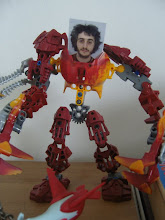UPDATE - The bug in the last schematic has been corrected. R2 had been incorrectly connected to Pin 7 and GND instead of Pin 7 and Pin 2.
I noticed awhile back that there were a few people in a few forums asking for simple ways to make LEDs pulse. During the summer I designed a circuit that pulsed a number of LEDs as part of a fancy dress costume. I was told that it looked great :-) Anyway, here is the circuit. It uses a single 555 timer in astable configuration to create a square wave. On the high part of the wave it triggers one LED, on the low part it triggers the other LED. The big capacitors cause the fading by charging and discharging the square wave into something more analog than digital.
Note: This is Version 3 of this circuit. A lot of people sent me messages saying that they were having a few issues building the circuit. There were a few problems with the previous schematics. The first was that the line connecting pin 2 and 6 could of been misinterpreted as also connecting to pin 7. I've now colour coded that line and put junction indicators (black dots) to show when two wires should be connected together. I recently realised that while making this correction I accidently connected R2 to GND instead of Pin 2. This is now fixed.
The other error was that the dotted line part had the led connected to ground after the capacitor instead of before it. As necro_nemisis pointed out this meant that LED1 was on a direct path from 5V to ground. I dread to think of all the dead leds that drawing mistake was responsible for!
Sorry it takes me so long to do corrections...
The effect is quite nice and you can add more capacitors in series to get several LEDs to light up in a chain. Here's a video where I had 4 sets of LEDs running from one 555 timer (shown at the end).
In addition, here's a photograph of how I wire up the 555 timer IC on some stripboard (with the strips running vertically from top to bottom). The only cut tracks are under the 555 chip. Note there is a red cable hidden from view behind the left capacitor which connects the other red cables together. I would only use this picture as a reference for the IC wiring, rather than the caps, as it is hard to see which track the capacitors are connected to.
Sunday 25 October 2009
Friday 2 October 2009
Milk Pixel
Following the last post we (myself and some colleagues from BRL) have decided to attempt to create a low-cost, low-complexity, interactive installation for the Craftivism open event at the Arnolfini.
The project is to be called Milk Pixel. Reasons for the name will become evident in time. We don't want to release too many details of what we are up to at the moment, but details will be appearing on the Craftisism wiki closer to the event (11 - 13 December).
We don't want to release too many details of what we are up to at the moment, but details will be appearing on the Craftisism wiki closer to the event (11 - 13 December).
The project is to be called Milk Pixel. Reasons for the name will become evident in time.
 We don't want to release too many details of what we are up to at the moment, but details will be appearing on the Craftisism wiki closer to the event (11 - 13 December).
We don't want to release too many details of what we are up to at the moment, but details will be appearing on the Craftisism wiki closer to the event (11 - 13 December).
Subscribe to:
Posts (Atom)



